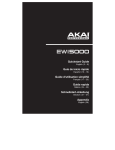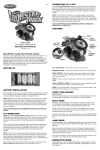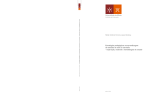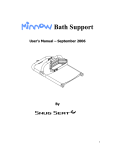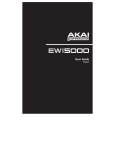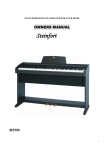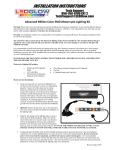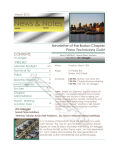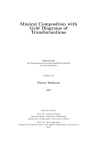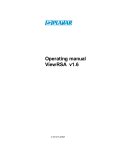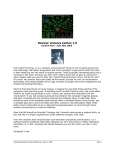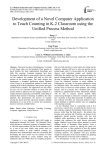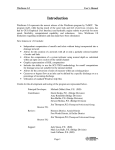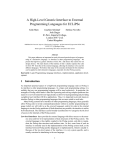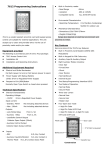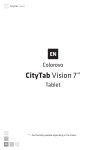Download 05-analysis of interactive technology in thea musgrave`s narcissus
Transcript
55
CHAPTER 5:
ANALYSIS OF INTERACTIVE TECHNOLOGY IN THEA MUSGRAVE’S
NARCISSUS, FOR CLARINET IN B-FLAT AND DIGITAL DELAY
My interest in Thea Musgrave’s Narcissus began after hearing clarinetist F.
Gerrard Errante’s recording in 1991.46 McGregor Boyle, my major advisor at the
Peabody computer music studios, was the technical director for one of the first
performances of Narcissus, and had had first-hand experience with the original
equipment as well as direct supervision from the composer in the concert production.
Advice from both Boyle and Errante was invaluable in preparing a performance of
Narcissus using my own digital delay equipment in April of 2000. The experience of
implementing Musgrave’s directions using new equipment led me to wonder if the
process could be formalized for the benefit of other players. A number of performers
interested in the piece have expressed their enthusiasm for such an effort as well. The
result is the following analysis of Musgrave’s digital delay system.
5.1
HISTORICAL BACKGROUND
Narcissus was written in 1987 for flute and digital delay, as one of four works
resulting from a National Endowment for the Arts Consortium Commissioning Grant.
The commissioning flutists were Wendy Rolfe, Harvey Sollberger, Patricia Spencer, and
46
Burton Beerman and F. Gerrard Errante, “Electric Clarinet,” (CPS – 8607,
Brooklyn, NY: Capstone Records, 1991), track 5
56
Robert Willoughby.47 Clarinetist F. Gerrard Errante, a noted specialist in music for
clarinet and electronics, served as technical consultant to Musgrave during the
composition of this work. In return, the composer made a transcription of Narcissus for
clarinet.48 Novello Music now publishes both flute and clarinet versions of this work.
Narcissus requires a digital delay system controlled from the stage by the
performer. Though relatively simple, the electronics are notated for the particular model
of digital delay equipment used by the composer, a Vesta Koza DIG-411. This
instrument is no longer manufactured. Even so, Narcissus is performed often, using
alternate equipment. Musgrave’s technical notes included in the score refer to several
other delay devices used by performers who were involved in the creation or early
performances of this work. However, the specificity of the notation for the DIG-411
poses a few problems in reconstructing the digital delay system for those who do not
have the benefit of advice from either the composer or the handful of performers who had
experience with the original implementation.
The score includes three pages of technical notes, compiled by Musgrave, Patricia
Spencer, Karen Bennet, and F. Gerard Errante, explaining the digital delay system. The
notes include stage diagrams, a sketch of the front and back panels of the DIG-411, and a
list of warnings and recommendations for performance setup and preparation. These
notes are very helpful since they provide some insights into the composer’s intentions, as
well as recommendations for handling certain common performance problems. However,
47
Patricia Spencer, “The Musical Shape of Technology,” Flutist Quarterly 19, no.
3 (1994), 47.
48
F. Gerrard Errante, email to the author, March 8, 2004.
57
several key digital delay effects are not explained in general terms, but are instead
expressed only as DIG-411 knob positions. In order to reconstruct the digital delay
system using updated or alternate technologies, the exact nature of these effects and their
parameters must be explicitly understood. This information is not contained in the
technical notes accompanying the score, nor is it to be found in any of the available
literature on this work to date.
The original Vesta Koza DIG-411 Digital Delay used by Musgrave to create this
piece has been in the possession of flutist and Narcissus co-commissioner Wendy Rolfe.
Dr. Rolfe has very kindly lent me the DIG-411 for this research, and I have compared the
functions of the original instrument to my own software-based reconstruction. With this
comparison, I have analyzed and defined the digital delay system as a set of signal
processing algorithms and related parameters, rather than as proprietary settings specific
to one now-obsolete device.
5.2
MUSICAL ROLE OF TECHNOLOGY
Narcissus is programmatic, musically illustrating the Greek myth of Narcissus,
who was so drawn to his own reflection in the water that he drowned trying to grasp it.
Musgrave provides the following program text, fragments of which appear throughout the
score:
Narcissus wanders through the forest, observing, enjoying …
unselfconscious but self-absorbed.
He sees a pool of water and then as he approaches notices his
reflection in the water. He is intrigued and then jumps back in fright.
Once more he approaches … it is still there.
58
Narcissus steps away from the pool to consider this
phenomenon. Several times he approaches, the figure is always there
watching him.
In the shimmering sunlight Narcissus seems to see this glorious
and attractive being moving in the rippling water. He is dazzled and
slowly holds out his arms. To his amazement the figure responds.
In awe and wonder Narcissus approaches closer and closer.
With a sudden change of mood Narcissus dances happily and playfully
… the figure echoing him. But then Narcissus begins to question
anxiously the lack of any independent response … is he being
mocked? He gets more and more agitated and finally in a fury he
rushes headlong into the water to grapple with the figure. The waves
surge up and Narcissus is drowned. There is a distant shimmering
vision of Narcissus and his reflection. Then in the setting sun the
vision disappears, the forest is empty and the pool lies undisturbed.49
Narcissus contains a great variety of moods and textures, from the
unaccompanied opening melody to a playful scherzo, and angular and agitated semiimprovised sections. The digital delay is more than an effect in this piece.
Programmatically, it assumes the role of Narcissus’ reflection, and at the end, the water
itself. Musically, the delay extends the solo instrument in time, creating a sonic
reflection that very nearly takes on a life of its own. Repeating delay effects are used to
create harmonies out of a single melodic line, and continuous delay-time modulation is
used to bend the pitch of the delayed sound.
Duration is listed in the score as 14 minutes, but this is variable considering the
numerous indications for rubato, open-ended pauses designed to allow electronic effects
to fade before moving on, and the variability of the semi-improvised segments. All
electronic sounds are generated in real time directly from the sound of the live clarinet
49
Thea Musgrave, Narcissus, for Solo Clarinet in Bb with Digital Delay,
(London: Novello, 1989).
59
using the basic features of a digital delay, and there are no pre-recorded elements.
Therefore, the electronics should be viewed as a flexible extension of the solo clarinet
rather than as an accompaniment.
5.3
ANALYSIS OF TECHNOLOGY COMPONENTS
The electronics required for Narcissus can be broken down into three basic parts:
a sound reinforcement system (microphone, amplifier, and loudspeakers), the digital
delay system (creating echo effects with several variable parameters), and a control
interface (foot switches, pedals, and other devices used to change delay settings during
performance). The following is an explanation of the required effects, the technical
methods for implementing them, and the musical contexts in which they appear.
5.3.1
Sound Reinforcement
The sound reinforcement requirements for Narcissus are straightforward and will
generally pose no special problems in adapting to available equipment. Musgrave
suggests a contact microphone to provide audio input from the clarinet to the digital delay
system.50 Other microphone systems can work equally well for this piece provided they
offer enough isolation from the loudspeakers to prevent signal feedback or other
extraneous noise.
The setup diagram included in the score specifies that the signal output from the
digital delay should be routed to a loudspeaker placed stage-right, while the amplified but
50
Musgrave, Narcissus score.
60
otherwise unaffected (“dry”) clarinet signal should be routed to a second speaker placed
stage-left.51 This relatively simple arrangement is intended to force an aural separation
between the clarinet and its digital “reflection.”
input
microphone
Digital Delay System
output
“dry”
signal
dry signal
Amplifier
delay
signal
delay signal
right speaker
left speaker
Figure 5.1. Audio system setup
5.3.2
Digital Delay System
A digital delay is a standard effect found on most commercially available signal
processing equipment. In its basic form it creates a simple echo – the input signal is
played back after a specified time interval has elapsed. This time interval is usually
expressed in milliseconds, but may range up to several seconds. Various manipulations
of the delay can produce interesting sonic results, some of which are called for in
Narcissus. Six digital delay parameters must be controlled during performance of this
work: delay interval (time), feedback, time modulation, hold, volume, and bypass.
51
Musgrave, Narcissus score.
61
Delay Time. Musgrave indicates three distinct delay times to be applied at
various points. The DIG-411 delay time was set using two separate knobs. The first
determined the base delay time (labeled “range”), with available settings of 2, 8, 32, 128,
and 512 milliseconds. The second selected a multiplier of the base delay time, with
values ranging continuously from 0.5, to 2 (labeled “time”). Therefore, the base delay
time could be set anywhere from one half to double the base delay time. Narcissus calls
for a base delay time set to 512 milliseconds throughout. Multiplier values of 0.5, 1.0,
and 2.0 are used, resulting in 3 separate delay times: 256, 512, and 1024 milliseconds.
In Figure 5.2 the delay time is set to 1024 milliseconds (512 x 2). With the sound
of the clarinet echoing approximately one second later, the first note, F, is repeated over
the E-flat, which is repeated over the D. In this passage, feedback (see below) is set to 6
(the highest setting in the piece), and therefore, the F is also heard repeating again (but
softer) over the D.
Figure 5.2. Score example: delay time
Delay feedback. Delay feedback creates a repeating echo by routing a portion of the
delay output back to its own input. Normally, the signal being fed back is at a lower
volume than the output, and the repeating echoes fade away gradually, with a duration
62
that depends on the amount of feedback. Musgrave uses this technique very effectively
to portray the environment and character of Narcissus:
Figure 5.3. Score example: delay feedback
In the passage shown in Figure 5.3, delay feedback creates a fairly thick texture.
The “shimmering sunlight” and “rippling water,” referred to by the program text, are
expressed in the accelerating and ascending arpeggios, which continue to repeat while
fading away (the “Hold” feature is explained below).
Delay feedback is indicated in Narcissus according to settings specific to the
DIG-411: values are indicated from 0 to 6 (on a scale from –10 to10). 52 Musgrave
describes feedback settings as controlling the “number of repeats” in the delay.53 This
should not imply that these repeats are discrete repetitions of a musical phrase, or that a
feedback setting of 6 will yield six repeats. In fact, a standard digital delay with variable
feedback will route an attenuated portion of the delayed signal (usually scaled from 052
Settings between 0 and –10 are not audibly different in any way from settings
between 0 and 10. It is not completely clear, in the absence of a DIG-411 user manual
exactly what the purpose of negative feedback values might be. Since negative values
are not used in Narcissus I will defer a definitive explanation of this curious feature of the
DIG-411 to future research.
53
Musgrave, Narcissus score, 1.
63
100 %) back to the delay inputs. The result is that sound repeating in the delay gradually
diminishes in volume as less and less of it is fed back each time. A feedback setting of 0
will simply produce a single echo of the input signal, with no portion of the echo
redirected to the delay input. The DIG-411 operates on this principle as well, so alternate
implementations of the delay system should be constructed using scaling factors
equivalent to the DIG-411 settings used by the composer.
The most logical assumption is that the settings from 0 to 10 would correspond to
feedback gain from 0 to 100% of the original signal, with each number on the dial
representing a 10% increment. Therefore, the maximum setting in the score, feedback at
6, would be interpreted as 60%. However, the DIG-411 behaves quite differently.
Settings above 6 actually produce some very undesirable effects: rather than diminishing
and fading away, the repeated echoes become louder and begin to distort, eventually
overloading the system. Apparently, settings above 6 create feedback levels effectively
greater than 100%, so that even the quietest sounds introduced into the system quickly
build into an overwhelming noise. It would seem that by limiting the delay settings in
Narcissus to 6 and below, Musgrave was simply working within the idiomatic boundaries
of the equipment on hand, rather than choosing settings according to any arbitrary
rules—a clear demonstration of Musgrave’s “hands on” approach to composition with
technology noted by Patricia Spencer in her description of this work and its inspiration.54
The practical question remains: using an alternate system, what levels of delay
feedback would most closely match the DIG-411 settings indicated in the score? To
54
Spencer, “The Musical Shape of Technology,” 47.
64
answer this question, I measured the output of the DIG-411 using a test application
created with Max/MSP software. With delay time set to 512 milliseconds (512 x 1), a
synthesized test signal was sent to the DIG-411 input, and the delay output was recorded
into an AIFF sound file for each of the three feedback settings (2, 4, and 6).55 A feedback
setting of 6 yielded approximately 18 seconds of diminishing repetitions (or 36 repeats).
With feedback at 4, repetitions lasted for 5 seconds (10 repeats). Feedback at 2 created
2.5 seconds of echo (5 repeats).
The same signal was then put through a software-based delay with variable
feedback (also in Max/MSP), in order to simulate the results of the DIG-411 test. The
DIG-411 feedback setting of 2 corresponded to a software delay feedback setting of 25%.
DIG-411 feedback of 4 was equivalent to 50%, and the DIG-411 setting of 6
corresponded most closely to 75% feedback in the software simulation.
It should be noted that on the DIG-411, feedback is not limited to discrete
settings. The feedback control knob is a potentiometer that allows for settings anywhere
along the range between the minimum (0) and maximum (10) values. Considering the
fact that the performer is required to quickly change these settings manually while
handling a flute or clarinet as well, it is likely that some variation would occur in
performance from the notated values. In actual practice with this machine, feedback
settings of 2, 4, and 6 would be rough targets. Furthermore, differences in microphones
55
A test tone (sine wave at 440 Hz) was used to first calibrate the DIG-411 input
so that the incoming signal would be as close to 0dB as possible (using the front panel
“Headroom” LED as a guide). The same synthesized tone (440 Hz sine wave with an
immediate attack and linearly descending decay envelop (1-0) over 500 msec) was sent to
the DIG-411 input for each of the three feedback settings. The “bell-like” sound of this
test signal enabled easy counting of repetitions.
65
(and their placement), individual playing style, and concert hall acoustics will produce
slightly different results in actual practice. My analysis of the DIG-411 feedback
settings, as 25, 50, and 75 percent of the delay output signal, should be used only as an
approximate guide for recreation of the digital delay. Some variation or adjustment may
be necessary to account for real-world performance situations.
Modulation. The modulation effect is not clearly defined in the score or in any other
published article to date concerning this work. According to clarinetist F. Gerard Errante
(who assisted the composer in designing the electronic effects), “the modulation effect is
meant to be a gradual, ‘undulating’ pitch transformation, like a slow, wide vibrato.”56
The modulation effect is applied at the end of the piece, as the character of
Narcissus drowns in the reflecting pool (“The waves surge up, the figure is shattered &
Narcissus is drowned”). In Figure 5.4, the modulation effect makes its debut, portraying
Narcissus’ watery demise. The short delay time in this passage (512 x 0.5, or 256
milliseconds) creates a very close mirror of the solo clarinet, warped slightly by the
oscillating pitch of the delayed signal. Delay feedback, set to 6, adds thickness to the
texture.
56
F. Gerard Errante, email to the author, March 9, 2000.
66
Figure 5.4. Score example: delay time modulation
Pitch fluctuation of this sort can be achieved by continuously varying
(modulating) the delay time by a small amount, similar to a typical “flange” effect. As
the delay time shifts, audio samples in the delay buffer are played back at a shifting rate
of speed. As playback speed increases, the pitch rises. As playback speed decreases, the
pitch falls. This phenomenon is similar to the “Doppler” effect on pitch from a moving
sound source, and it should be noted that this pitch shifting effect created by a
continuously variable delay only occurs while the delay time is still changing. Once the
delay time is set, the pitch stabilizes at its original pitch level. Furthermore, the amount
of pitch shifting is directly related to the amount of offset from the original delay time
and the speed of modulation. Larger offsets at faster speeds create more radical pitch
shifting effects.
The score indicates that “[m]odulation speed remains at 0 throughout, modulation
depth ranges from 0 – 10 (0 – 3 [sic] used).”57 According to the front panel of the DIG411, modulation speed is actually scaled from .1 Hz to 10 Hz, with a continuous range of
settings available between the minimum and maximum settings. Therefore the
57
Musgrave, Narcissus. Although the technical notes indicate modulation values
from 0-3, the score contains only modulation settings from 0 to 2.
67
modulation speed setting of zero indicated in the score should be implemented as 0.1 Hz
when using other equipment. The score indicates depth values of 0, 1, and 2 on a scale of
0-10. An analysis of the of the DIG-411 output, with an input signal of a sine tone at 440
Hz, shows that a modulation setting of 0 causes no pitch deviation, a setting of 1 causes a
pitch fluctuation between 338 and 442 Hz, and a modulation setting of 2 produces a pitch
variation from 442 to 258 Hz. Using a modulated delay constructed in Max/MSP
software, I was able to produce the same pitch variations as the DIG-411 and record the
amount of delay time modulation required to produce such results in terms of variation
from the base delay time in milliseconds. In other words, to produce the ± 2 Hz pitch
variation recorded from a modulation setting of 1, the delay time should be varied by
approximately 7 milliseconds in either direction, i.e. delay time continuously fluctuates
between 1017 and 1031 milliseconds at a rate of one cycle per 10 seconds (0.1 Hz). For a
mod setting of 2 (pitch fluctuation between 422 and 458 Hz), a delay time modulation of
21 milliseconds is required, i.e. delay time fluctuates gradually between 1003 and 1045
milliseconds.
One caveat: on the Vesta Koza DIG-411, the knob control for modulation depth
allows for continuous adjustment between values, rather than discrete settings.
Therefore, the exact values for pitch variation may be slightly different from one
performance to the next. The values I have come up with should be used as a guideline
only, and not as absolute values. However, I believe that this analysis is precise enough
to serve as a guide for future implementations of the modulation effect.
68
Hold. The hold function allows the performer to capture a short duration of sound in the
delay line that loops continually. While the hold is engaged, no new sounds are added to
the delay, so the hold loop becomes a background to whatever the performer plays at that
time.
The DIG-411 had a particularly smooth hold feature, with no audible clicks or
other artifacts creeping in to the sound when the feature is engaged or released.
Musgrave mentions this requirement as an absolute necessity for any performance
implementation of the delay system.58
The hold effect is used quite effectively in Narcissus, especially at measure 247
(Giocoso – Dopio movimento, “Narcissus then responds playfully, happily …”). Figure
5.5 shows delayed arpeggios synchronizing to form brief ostinato chords that accompany
the continuing melody in the clarinet. The four notes before the hold is engaged (B-G#G-F) align as a chord, since the delay time coincides with the eighth note pulse, and they
continue to repeat as background accompaniment for the next two and a half measures
until the hold is released.
Figure 5.5. Score example: delay hold
58
Musgrave, Narcissus score.
69
Volume. The volume of the delay output is to be controlled by foot pedal. Several places
in the score call for the delay signal to gradually fade in or out to silence. The original
setup used a simple analog volume pedal between the delay output and the loudspeaker.
This technique is used programmatically in Narcissus to illustrate the main character
approaching or retreating from the reflecting pool where he sees his own image:
Figure 5.6. Score example: delay volume
Bypass. The bypass function is used in Narcissus to turn the entire delay system on or
off. This feature is used at the opening of the piece so that the unaccompanied
introductory section (“Narcissus wanders through the forest …”) is unaffected by the
digital delay. Once the bypass is disengaged (by foot switch control), the delay system is
active.
Figure 5.7. Score example: delay bypass
70
Digital Delay System Summary. The digital delay system for Narcissus consists of: 1) an
audio input source (a microphone); 2) an echo effect with variable delay time, feedback,
time/pitch modulation, and functions for delay hold, bypass, and volume control; and 3)
audio output via amplifier and loudspeakers. The delay effects can be easily described in
terms of standard audio signal processing algorithms and the DIG-411 settings given in
the score can be translated into specific effect parameters. Table 5.1 (below) summarizes
the required effects and their variable parameters as notated in the score and as actual
values to be used as a guide for reconstruction with alternate equipment.
71
Table 5.1. Delay effect parameters: notated and actual values
Effect
Delay Time (time interval
between input signal and its
echo)
Notated
512 x 0.5
512 x 1
512 x 2
Actual Values
256 milliseconds
512 milliseconds
1024 milliseconds
Feedback (amount of delay
output signal routed back to its
input; duration of repeating
delay)
0
2
4
6
No feedback (1 repeat)
25%
50%
75%
Modulation Depth (slow cyclical
pitch shifting; Speed = 0.1 Hz)
0
1
2
No change
Delay time +/- 7 msec
Delay time +/- 21 msec
Hold (delay loops continuously
in background allowing
“ostinato” effect)
On/Off
Feedback = 100%, Input Off
Bypass (disengages the entire
delay system by cutting input)
On/Off
Input Off
Volume (output level from the
delay system)
<>
Continuous control from 0 to full
volume
Figure 5.8 shows the complete digital delay system and the signal flow between
the various components:
Hold: bypass “on”;
feedback 100%;
bypass:
{on/off}
Mod: speed = 0.1 Hz;
depth = {7, 65} msec
from
microphone
Delay
input
Delay time:
{256, 512, 1024} msec
volume
Feedback:
{0, 25, 50,-75}%
Delay
output
original (“dry”) signal
Figure 5.8. The complete digital delay system
delay
signal
dry
signal
72
5.3.3
Control Interface
Because variable parameters must be changed during performance, an interface of
some sort is necessary to control the delay system from the stage. Musgrave’s directions
in the score are so specific to the DIG-411 that any new realization of the work will
require some departure from the notation. The DIG-411 has back panel inputs for a hold
pedal, a bypass pedal, and a volume pedal. On the front panel are knob controls for
“Input” (0 – 10), “Feed Back” (-10 – 10), Modulation ‘Speed” (0.1 – 10 Hz) and “Depth”
(0 – 10), Delay ““Range” (2, 16, 64, 128, 512) and “Time” (0.5 – 2.0), and “Delay” (0 –
10) and “Dry” (0 – 10) Output levels. Additional on/off switches control “Hi-Cut”
(filter), “Bypass,” and “Hold.” The Vesta Koza DIG-411 front panel is shown in figure
5.9.
Figure 5.9. Vesta Koza DIG-411 front panel
In practice, the performer would be required to manipulate knobs 2 (feedback), 4
(modulation, depth), and 6 (time) by hand. Bypass, hold, and volume are controlled by
two foot-switches and a connected to inputs on the back panel of the DIG-411 and a
volume pedal placed between the DIG-411 output and the amplifier.
Alternate delay systems (whether hardware- or software-based) may not feature
the same physically accessible controls for the aforementioned variable parameters.
Aware of this fact at the time the clarinet version was published, Musgrave mentions the
73
possibility of using a third footswitch to advance through a sequence of pre-set delay
settings.59 Such an arrangement allows the performer to easily change delay system
parameters while remaining focused on the music. The points in the score that require
changes to these three parameters are as shown in Table 5.2.
Table 5.2. Pre-programmable effects changes
Score Event
Delay time F/B Mod.
1. m. 1 - “Narcissus wanders through the forest, observing …” 512 x 0.5
0
0
2. m. 78 - “Is ‘It’ Still there?”
2
3. m. 89 - “Narcissus steps back from the pool …”
512 x 1
4
4. m. 172 - “In the shimmering sunlight …”
6
5. m. 247 - “Narcissus then responds playfully, happily …”
512 x 0.5
4
6. m. 316 - “Narcissus anxiously questions…”
6
7. m. 370 - “The waves surge up … Narcissus is drowned”
1
8. m. 387 - “All that remains is a distant shimmering vision …”
2
9. m. 398
512 x 2
10. m. 426
1
11. m. 428 – “The vision disappears … the forest is empty …”
0
Therefore, eleven pre-programmed delay system changes are required, two of
which require changes to two parameters simultaneously (events 3 and 5). Many
strategies currently exist for cycling through a series of effects changes, either by
footswitch control or by other means. More than likely, new strategies will emerge in the
near future for controlling parameter changes within an interactive computer music
system, to which this list of control events should be easily adaptable.
59
Musgrave, Narcissus, performance notes preceding the score (“Requirements”).
74
5.4
SUMMARY
The digital delay system required for Narcissus could be easily reconstructed
using a wide range of equipment or software-based audio processing environments. I
have based my analysis of the digital delay system, and its use in the score, on a close
examination of the original Vesta Koza DIG-411 system used by Musgrave. Therefore I
hope that it leads to future performance realizations that are faithful to the intentions of
the composer. By translating DIG-411 settings into specific parameter values for
standard signal processing algorithms, I hope to provide enough information to serve as a
reliable guide for anyone attempting a recreation of the digital delay system for Narcissus
using alternate equipment or technology. My own software-based realization of the
digital delay system is discussed in detail in chapter 9.




















